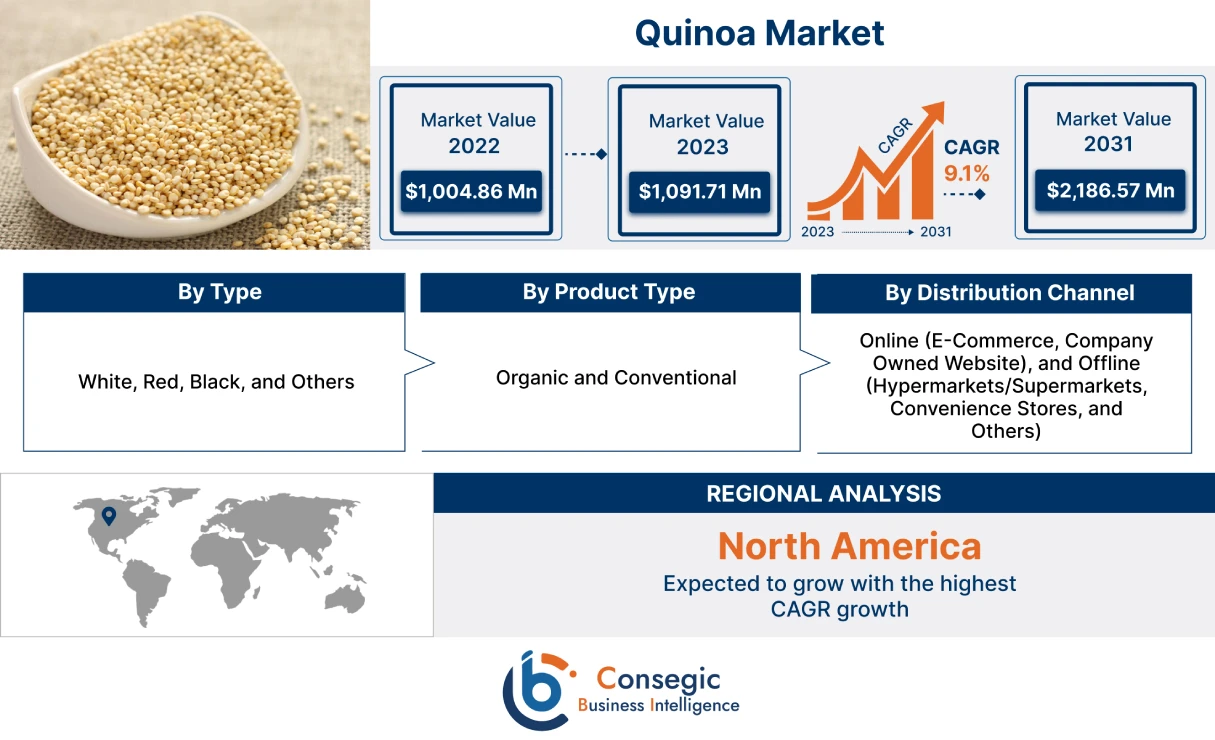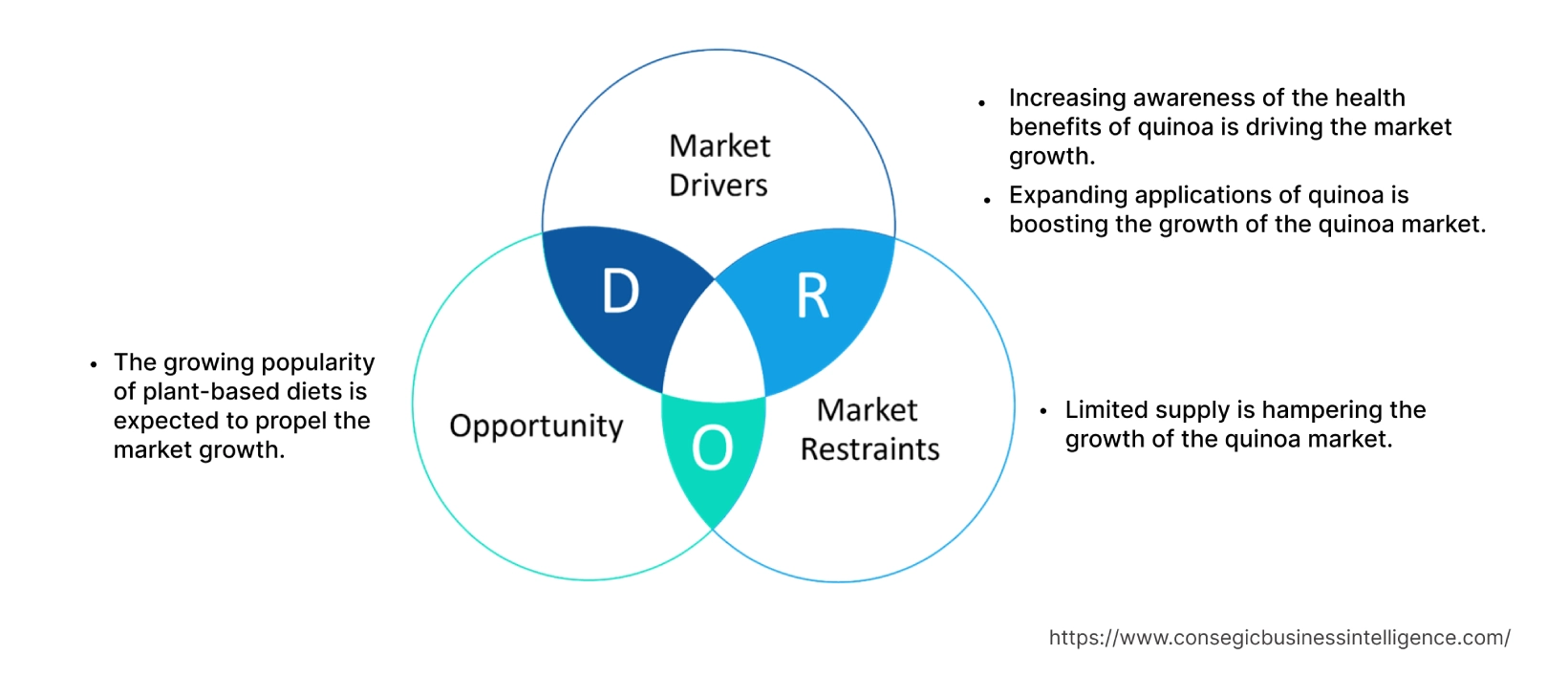Quinoa Market Size :
Consegic Business Intelligence analyzes that the quinoa market size is growing with a CAGR of 9.1% during the forecast period (2023-2031), and the market is projected to be valued at USD 2,186.57 million by 2031 and USD 1,091.71 million in 2023 from USD 1,004.86 million in 2022.
Quinoa Market Scope & Overview:
Quinoa is a seed of the chenopodium quinoa plant. It is native to South America, where it has been cultivated for thousands of years. Quinoa was a staple food of the Incas, which is primarily consumed compared to other grains. It is a highly nutritious food. As per the analysis, the grain is a good source of protein, fiber, vitamins, and minerals. It is also gluten-free, making it a good choice for people with celiac disease or gluten intolerance. It is a versatile food that can be eaten in a variety of ways. It can be cooked as a side dish, used in salads, or added to soups and stews. It can also be ground into flour and used to make baked goods.
How is AI Transforming the Quinoa Market?
AI is increasingly being used in the quinoa market, particularly for facilitating precision agriculture with AI-powered drones and sensors, optimizing supply chains through predictive analytics and logistics, enhancing post-harvest processes with robotics for sorting and quality control, and providing deep market insights for better consumer behavior modeling and product development. These advancements lead to more efficient cultivation, improved product quality, and reduced operational costs, in turn creating a more competitive and sustainable industry.
Moreover, AI-powered drones and sensors can be used in quinoa cultivation and farming to monitor soil health, water usage, and pest control, allowing farmers to optimize practices for higher yields and reduced environmental impact. Therefore, the aforementioned factors are expected to positively impact the market growth in upcoming years.
Quinoa Market Insights :
Quinoa Market Dynamics - (DRO) :
Key Drivers :
Increasing awareness of the health benefits is driving the market expansion
Quinoa is a nutrient-rich food that is high in protein, fiber, vitamins, and minerals. It is also gluten-free, making it a good choice for people with celiac disease or gluten intolerance. As consumers are becoming more aware of the health benefits of this grain, demand for the product is increasing drastically. Furthermore, as per the analysis, the grain is a complete protein, meaning that it contains all nine essential amino acids that one's body cannot produce on its own. This makes the grain a good source of protein for both meat-eaters and vegetarians alike. It is a good source of vitamins such as vitamins B1, B2, B3, B6, and E, as well as minerals such as magnesium, iron, and phosphorus. Overall, increasing awareness of the health benefits of this grain is driving the quinoa market growth globally.
Expanding applications is boosting the expansion of the quinoa market
Quinoa is a versatile food that can be used in a variety of dishes, including salads, soups, stews, and baked goods. This is driving innovation in the quinoa market, as new products are being developed to meet the needs of different consumers. Also, increasing demand for pasta, flour, and snacks prepared using quinoa is driving the market expansion further. Furthermore, as per the analysis, increasing awareness of the link between diet and health, and rising obesity rates is impacting the expansion of the market positively. For instance, according to a recent report by the Centers for Disease Control and Prevention in 2022, The U.S. obesity prevalence was around 41.9% between 2017 to March 2020. Hence, wide applications of this grain in different dishes and the increasing demand for healthy diets due to rising health concerns such as obesity, among others are driving the quinoa market trends.
Key Restraints :
Limited supply is hampering the expansion of the quinoa market
Quinoa is a relatively new crop in many parts of the world, and its production is limited. This is due to several factors, including the fact that quinoa is a delicate crop that requires specific climatic conditions to grow. Limited supply is thus leading to higher prices for this grain, which is deterring some consumers from purchasing it. Also, as per the analysis, the grains are generally more expensive than other grains, such as rice and wheat. Hence, due to the aforementioned factors, the quinoa market growth is being hampered to a large extent.
Future Opportunities :
The growing popularity of plant-based diets is expected to propel the market expansion
A large number of consumers across the globe are choosing to follow plant-based diets, either for ethical or health reasons. It is a good source of protein for consumers who are following plant-based diets, as it is known as a complete protein. Plant-based diets can be beneficial for health in several ways, including reducing the risk of heart disease, stroke, type 2 diabetes, and some types of cancer. Furthermore, as per the analysis, increasing concerns of diabetes, strokes and other health concerns is forecasted to increase the market trends in the upcoming years. For instance, according to a report by the Centers for Disease Control and Prevention in 2022, 37.3 million Americans are suffering from diabetes and 96 million American adults are suffering from prediabetes. Hence, due to the increasing popularity of plant-based diets owing to advantages in mitigating major health concerns, the quinoa market is expected to flourish in the forecast period.
Quinoa Market Report Insights :
| Report Attributes | Report Details |
| Study Timeline | 2017-2031 |
| Market Size in 2031 | USD 2,186.57 Million |
| CAGR (2023-2031) | 9.1% |
| By Type | White, Red, Black, and Others |
| By Product Type | Organic and Conventional |
| By Distribution Channel | Online (E-Commerce, Company Owned Website), and Offline (Hypermarkets/Supermarkets, Convenience Stores, and Others) |
| By Region | North America, Europe, Asia-Pacific, Latin America, and Middle East & Africa |
| Key Players | Grain Millers, Inc., ARDENT MILLS, Jiwa, Culingo, Andeangrain, The British Quinoa Company, Impact Foods International Ltd., Blue Lake Milling, Morning Foods Ltd, and Avena Foods Limited |
| Geographies Covered | |
| North America | U.S. Canada Mexico |
| Europe | U.K. Germany France Spain Italy Russia Benelux Rest of Europe |
| APAC | China South Korea Japan India Australia ASEAN Rest of Asia-Pacific |
| Middle East and Africa | GCC Turkey South Africa Rest of MEA |
| LATAM | Brazil Argentina Chile Rest of LATAM |
| Report Coverage | Revenue Forecast, Competitive Landscape, Growth Factors, Restraint or Challenges, Opportunities, Environment & Regulatory Landscape, PESTLE Analysis, PORTER Analysis, Key Technology Landscape, Value Chain Analysis, Cost Analysis, and Regional Trends & Forecast |
Quinoa Market Segmental Analysis :
By Type :
The type segment is categorized into white, red, black, and others. In 2022, the white segment accounted for the highest quinoa market share of 41.10% in the quinoa market. White quinoa is the most common type of quinoa and is known for its mild flavor and fluffy texture. It also has a mild, nutty flavor that makes it versatile and easy to use in a variety of dishes. It is also a good all-purpose quinoa, meaning that it can be used in both hot and cold dishes. White quinoa is a nutritious food that is high in protein, fiber, vitamins, and minerals. It is also gluten-free, making it a good choice for people with celiac disease or gluten intolerance. Furthermore, increasing numbers of celiac diseases is enforcing larger demand for the product. For instance, according to a recent report by Celiac Disease Foundation in 2023, people with a first-degree relative with celiac disease have a 1 in 10 risk of developing celiac disease. Furthermore, based on the analysis, the report also mentions people with celiac disease have a 2x greater risk of developing coronary artery disease and a 4x greater risk of developing small bowel cancers. Hence, due to the wide health benefits of white quinoa, the segment is experiencing significant quinoa market trends.
Moreover, the red segment is expected to grow at the fastest CAGR over the forecast period in the quinoa market. It is growing rapidly as consumers are becoming more aware of the unique flavor and texture of red quinoa. Also, the trends of the red quinoa segment is being driven by the increasing popularity of plant-based diets. Red quinoa is a good source of protein and is highly beneficial for people who are following plant-based diets. Hence, due to the aforementioned advantages of red quinoa, the segment is experiencing positive growth in the quinoa market.
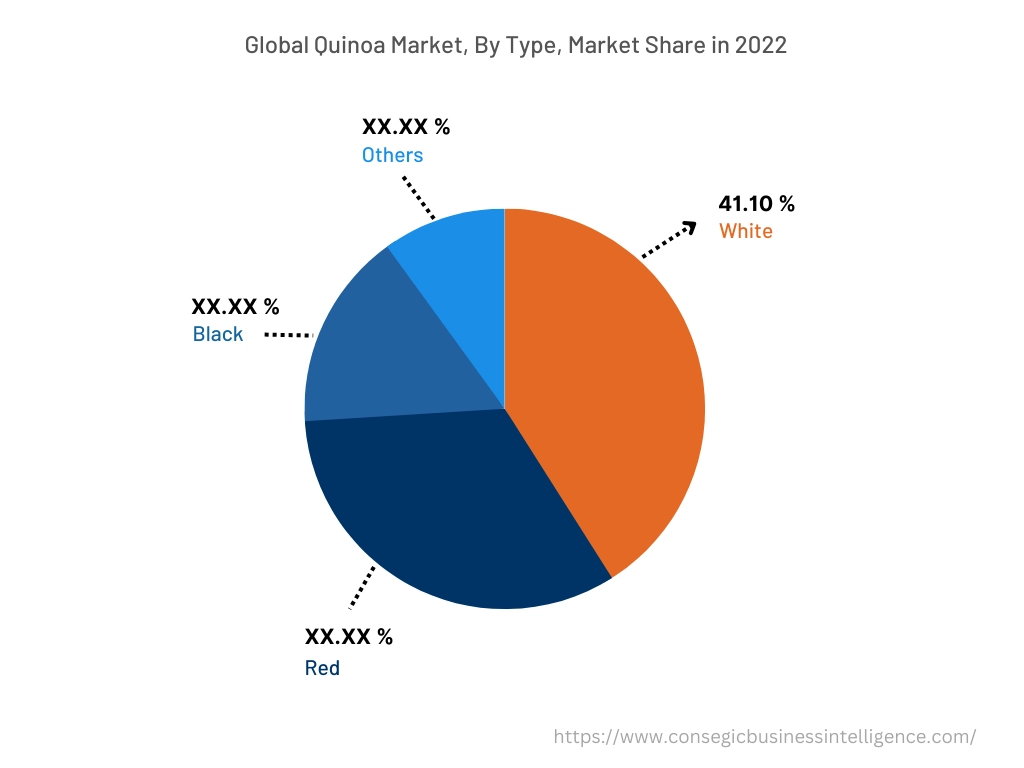
By Product Type :
The product type segment is categorized into organic and conventional. In 2022, the organic segment accounted for the highest market share and is expected to grow at the fastest CAGR over the forecast period in the quinoa market. Organic quinoa is produced without the use of synthetic pesticides, herbicides, and fertilizers. This makes it a more sustainable option and a better choice for consumers who are concerned about the health effects of synthetic chemicals. The organic quinoa market is also being driven by the growing popularity of organic food and the increasing awareness of the health benefits of organic food. It is becoming increasingly popular as consumers are becoming more aware of the health and environmental benefits of organic food. Organic quinoa is a nutritious food that is high in protein, fiber, vitamins, and minerals. It is also gluten-free, making it a good choice for people with celiac disease or gluten intolerance. It is a more ethical choice than conventional quinoa as organic quinoa is produced in a way that is better for the environment and for the health of farm workers. Hence, due to the aforementioned factors, the segment is witnessing significant quinoa market demand.
By Distribution Channel :
The distribution channel segment is categorized into online and offline. In 2022, offline segment accounted for the highest market share in the quinoa market. This is due to the fact that the grain is a relatively new food product and consumers prefer to purchase it from physical stores where they can see and check the product before purchasing it. Also, the wide availability of different hypermarkets and convenience stores are driving larger demand for the product through an offline channel. Hence, due to the aforementioned factors, the segment is experiencing a significant quinoa market trends.
Moreover, the online segment is expected to grow at the fastest CAGR over the forecast period in the quinoa market owing to various consumers preferring the online method of purchase. The expansion of the online distribution channel is also being driven by the increasing availability of the grains on e-commerce websites and online marketplaces. Online shopping is convenient for consumers, as they can purchase this grain from the comfort of their own homes. Furthermore, online websites often offer competitive prices on this products and many online retailers offer free shipping and returns on quinoa products. Hence, due to the advantages of online distribution channel, the segment is witnessing positive quinoa market demand.
By Region :
The regional segment includes North America, Europe, Asia Pacific, the Middle East and Africa, and Latin America.
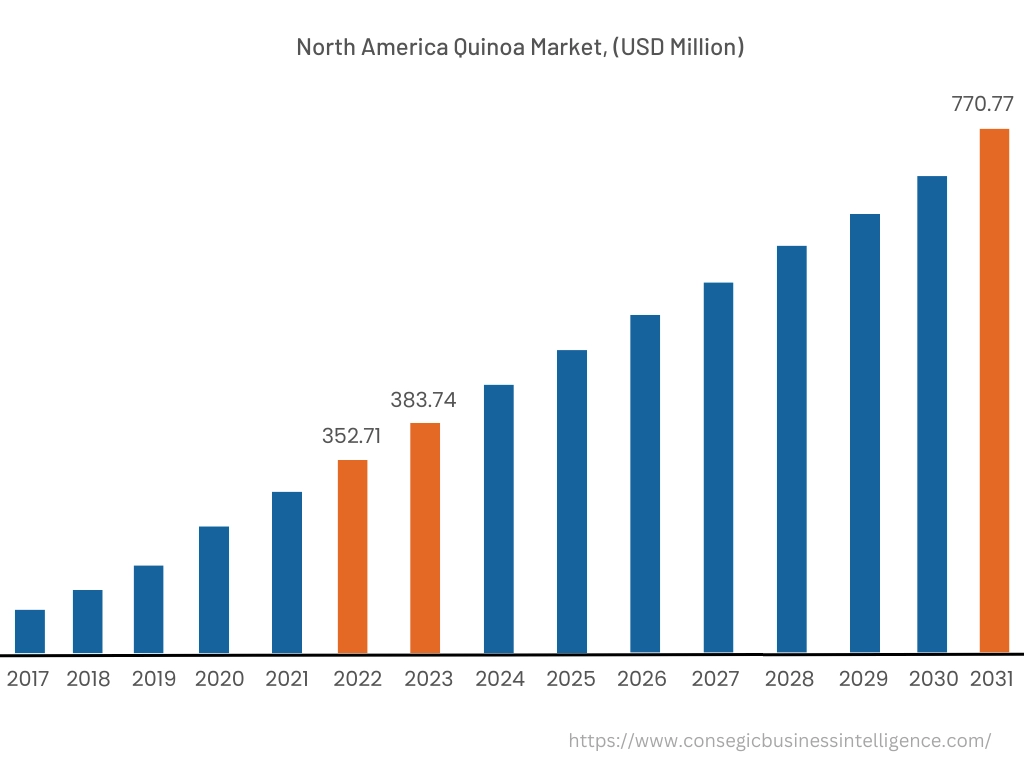
In 2022, North America accounted for the highest market share at 35.10%, was valued at USD 352.71 million in 2022 and USD 383.74 million in 2023, it is expected to reach USD 770.77 million in 2031. In North America, the U.S. accounted for the highest market share of 62.30% during the base year 2022. This is due to the increasing awareness of the health benefits of the grain and the growing popularity of plant-based diets in the region. Based on the quinoa market analysis, the introduction of new and advanced products that are tailored to the specific needs and preferences of consumers in the region is further driving the trends of the market in North America. Furthermore, increasing cases of heart disease, obesity, and others in the region are driving the market growth further. For instance, according to a report by the Centers for Disease Control and Prevention in 2022, heart disease is the leading cause of death for men, women, and people of most racial and ethnic groups in the U.S. About 695,000 people in the U.S. died from heart disease in 2021.
Hence, due to the aforementioned factors, the quinoa market is experiencing significant growth in North America.
Moreover, Asia Pacific is expected to witness significant growth over the forecast period, growing at a CAGR of 9.6% during 2023-2031 owing to rising trend for healthy and nutritious food products in the region. Rising disposable incomes and growing urbanization are acting as catalysts for the growth of the quinoa market. Also, consumers in Asia Pacific are becoming more exposed to international cuisines, which is leading to an increased trend for new and exotic food products, such as quinoa. Thus, due to the aforementioned factors, the quinoa market is witnessing positive growth in the region.
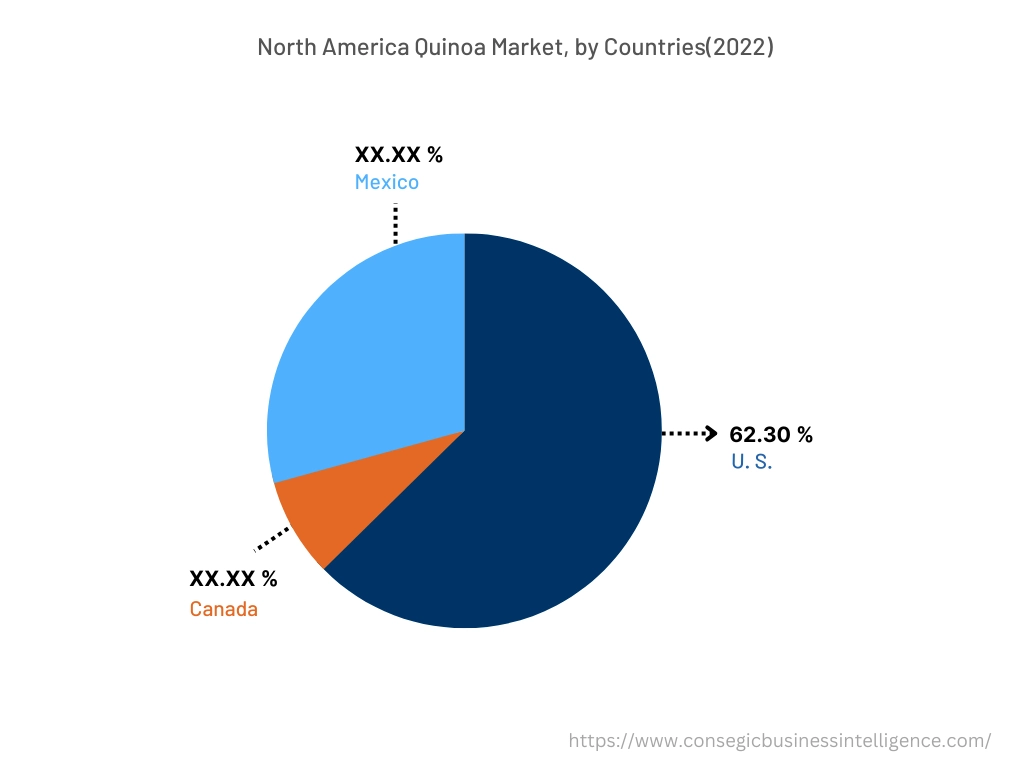
Top Key Players & Market Share Insights:
The global quinoa market is highly competitive, with several large players and numerous small and medium-sized enterprises. These companies have strong research and development capabilities and a strong presence in the market through their extensive product portfolios and distribution networks. The market is characterized by intense competition, with companies focusing on expanding their product offerings and increasing their market share through mergers, acquisitions, and partnerships. The key players in the global quinoa industry include-
- Grain Millers, Inc.
- ARDENT MILLS
- Blue Lake Milling
- Morning Foods Ltd
- Avena Foods Limited
- Jiwa
- Culingo
- Andeangrain
- The British Quinoa Company
- Impact Foods International Ltd.
Recent Industry Developments :
- In June 2021, Ardent Mills, the premier flour-milling and ingredient company, in partnership with Nutrien Ag Solutions, the retail division of the world's largest crop inputs company, announced the advancement of its regenerative agriculture program. The program is aimed at strengthening the soil ecosystem and helping producers improve their farms' productivity and profitability.
- In April 2021, Morning Foods Ltd expanded its oat milling factory in Crewe. The company aims to boost output over the next four years by more than 50% owing to the major expansion of its oat milling capabilities at its sites in Crewe.
Key Questions Answered in the Report
What was the market size of the quinoa industry in 2022? +
In 2022, the market size of quinoa was USD 1,004.86 million.
What will be the potential market valuation for the quinoa industry by 2031? +
In 2031, the market size of quinoa will be expected to reach USD 2,186.57 million.
What are the key factors driving the growth of the quinoa market? +
Increasing awareness of the health benefits of quinoa is fueling market growth at the global level.
What is the dominating segment in the quinoa market by type? +
In 2022, the white segment accounted for the highest market share of 41.10% in the overall quinoa market.
Based on current market trends and future predictions, which geographical region is the dominating region in the quinoa market? +
North America accounted for the highest market share in the overall quinoa market.
